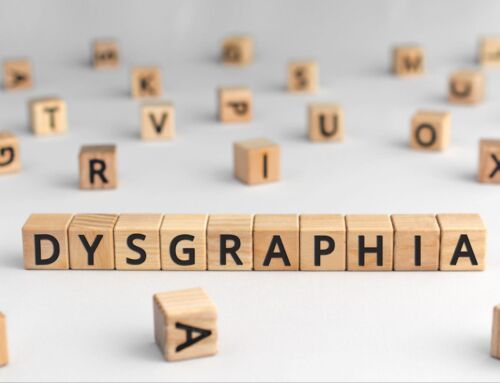Does My Child Have Dysgraphia?
As parents, we cherish the moments when we first witness our children putting pencil to paper. They’re attempting to capture their thoughts and express their creativity.
However, for some children, the journey into the world of writing is fraught with challenges that extend beyond the typical struggles of learning to form letters.
If you’ve noticed that your child consistently grapples with handwriting, struggles to organize thoughts on paper, or experiences an overwhelming aversion to writing tasks, you may wonder if something is more at play. This is where the enigma of dysgraphia enters the picture.
Does my child have dysgraphia? Read on to find out.
What is Dysgraphia?
Dysgraphia is a neurological condition that affects a person’s ability to write.
It specifically affects handwriting and spelling. It’s a learning disability that is not related to intelligence. People with dysgraphia often have average to above-average intelligence.
The exact cause of dysgraphia is not well understood. It is believed to involve difficulties in the brain’s ability to process and transmit writing-related information.
Early dysgraphia identification and intervention can be crucial in helping people develop practical writing skills and overcome the associated challenges.
Dysgraphia Symptoms for Child
There are some signs of dysgraphia you should look out for.
One of the primary symptoms is poor handwriting. You may see inconsistent letter size and formation, irregular spacing, and difficulty maintaining a uniform writing style. Teaching them how to write in the first place can be a struggle.
Children with dysgraphia often struggle with spelling. You may notice them making frequent errors, even with common words. They may find it challenging to remember and apply spelling rules.
Fine motor skills can be a significant challenge for children with dysgraphia. Tasks requiring precise hand movement may take much work. These could include things such as using scissors or tying shoelaces.
Additionally, these children may exhibit awkward pencil grips and tire quickly during writing tasks.
Another symptom is difficulty organizing thoughts on paper. Children with dysgraphia may struggle to express themselves coherently in writing. They may face challenges in planning and structuring written assignments.
They could also take an unusually long time to complete writing tasks. This slow writing speed can affect their ability to keep up with assignments in the classroom.
Some children with dysgraphia may experience physical discomfort or pain while writing. This can make them reluctant to engage in writing tasks.
Inconsistency in letter formation is common. Children with dysgraphia may have trouble copying text accurately from a board or book. Word processing on a computer can also be challenging, as they may need help typing and using a keyboard effectively.
Diagnosing a Child With Dysgraphia
Diagnosing dysgraphia typically involves a comprehensive assessment conducted by professionals.
Teachers and parents provide information about the child’s developmental history, including concerns about writing skills and related difficulties.
An educational assessment might be conducted. This may include standardized tests, classroom observations, and reviewing the child’s written work.
Testing may be conducted to assess cognitive abilities, including memory, processing speed, and executive functions. This helps identify any underlying factors contributing to the writing difficulties.
Occupational therapists may assess the child’s fine motor skills. That could include hand strength, coordination, and dexterity. Dysgraphia is often associated with challenges in these areas.
It’s important to rule out other conditions contributing to writing difficulties. These could include things like attention deficit hyperactivity disorder or specific learning disorders.
Learning with Dysgraphia
Learning with dysgraphia can present challenges. However, with appropriate support and strategies, kids with dysgraphia can still succeed academically.
Embrace technology tools to reduce the reliance on handwriting. Examples include speech-to-text software, word processors, and typing programs. These tools can help children express their thoughts without the physical challenges of writing.
Graph paper or paper with raised lines can assist individuals with dysgraphia in maintaining proper spacing and alignment. Some children find it helpful to use paper with wider lines. These pages allow for larger handwriting.
Focus on developing keyboarding skills as an alternative to handwriting. Learning to type efficiently can significantly enhance the speed and ease with which students with dysgraphia can produce written work.
You can help your child by breaking down writing assignments into smaller, more manageable tasks. This allows individuals with dysgraphia to focus on one aspect at a time. That reduces the cognitive load associated with writing.
Visual supports, such as graphic organizers, can help individuals organize their thoughts before writing. This can be particularly beneficial for planning and structuring written assignments.
Getting More Help With Dysgraphia
You don’t have to help your child manage their learning disorder alone.
If your child qualifies for special education services, work with the school to develop an Individualized Education Plan. An IEP outlines specific goals, accommodations, and services tailored to the child’s needs.
Maintain open communication with your child’s teachers. Share information about dysgraphia and the strategies that work well.
Go through any accommodations outlined in the IEP. Collaborate with teachers to ensure the child’s needs are understood and met.
Consider involving an occupational therapist if fine motor skills are a significant challenge. Occupational therapy can help improve handwriting, fine motor skills, and overall coordination.
Connect with local or online parent advocacy groups for dysgraphia. These groups can provide valuable insights, resources, and support from parents who have navigated similar challenges.
Explore tutoring options that specialize in supporting children with dysgraphia. Tutors can provide targeted interventions and strategies to help improve writing skills.
Schools that specialize in learning disorders can benefit students with dysgraphia. These schools have educators experienced in these disorders who can adapt to different learning styles. They can also give parents tips on how to help their child succeed.
Does My Child Have Dysgraphia? Find Out Today
Does my child have dysgraphia? There may not be a clear-cut answer. If you have suspicions, it might be time to get your child evaluated.
Is your child struggling with learning disorders? READ Academy of Sacramento’s educators have the educational background to help them succeed.
Contact us today to learn more.



